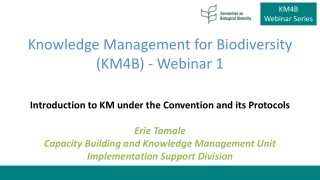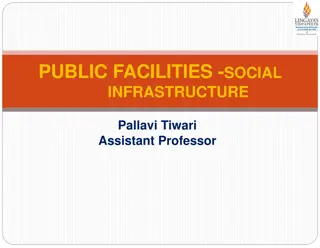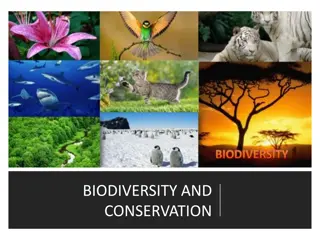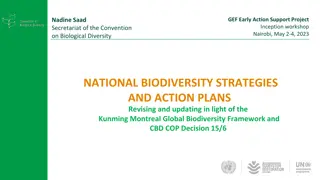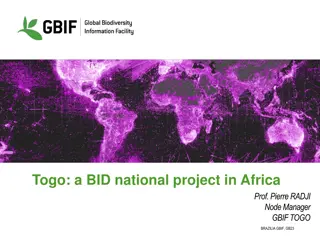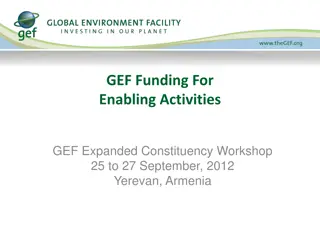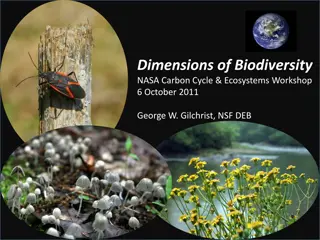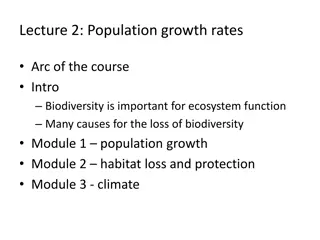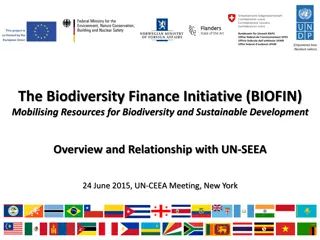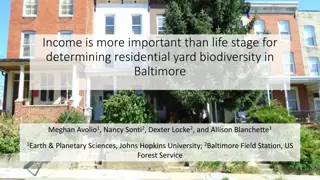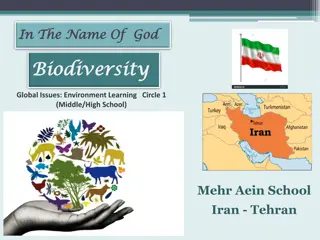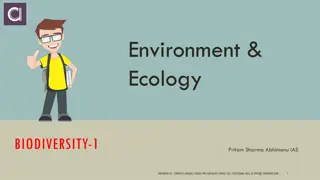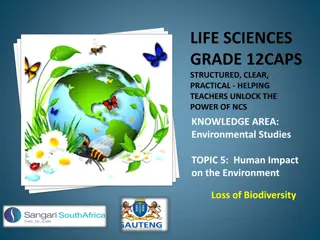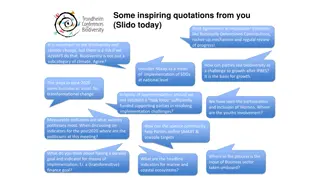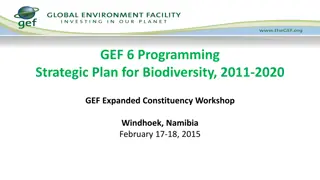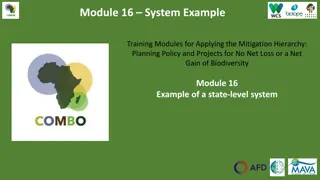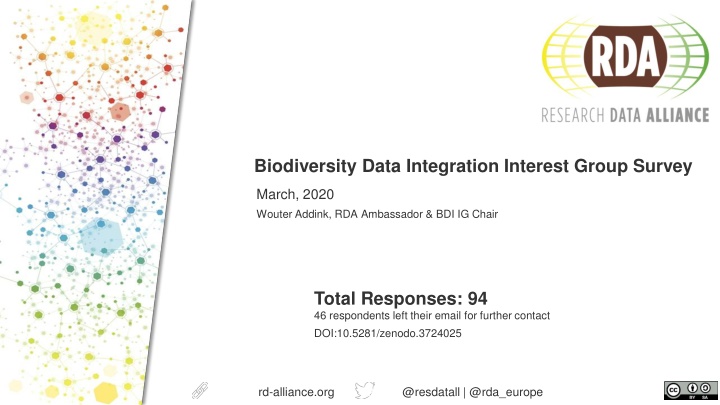
Biodiversity Data Integration Survey Results
This survey conducted by the Biodiversity Data Integration Interest Group gathered responses from researchers regarding their familiarity with the Research Data Alliance and its outputs. The results provide insights into the engagement levels and perspectives on RDA initiatives within the biodiversity data community. The survey aimed to assess the relevance of RDA recommendations and the involvement of participants in RDA outputs' development.
Download Presentation

Please find below an Image/Link to download the presentation.
The content on the website is provided AS IS for your information and personal use only. It may not be sold, licensed, or shared on other websites without obtaining consent from the author. If you encounter any issues during the download, it is possible that the publisher has removed the file from their server.
You are allowed to download the files provided on this website for personal or commercial use, subject to the condition that they are used lawfully. All files are the property of their respective owners.
The content on the website is provided AS IS for your information and personal use only. It may not be sold, licensed, or shared on other websites without obtaining consent from the author.
E N D
Presentation Transcript
Biodiversity Data Integration Interest Group Survey March, 2020 Wouter Addink, RDA Ambassador & BDI IG Chair Total Responses: 94 46 respondents left their email for further contact DOI:10.5281/zenodo.3724025 13/03/2025 rd-alliance.org @resdatall | @rda_europe @resdatall | @rda_europe rd-alliance.org 1
About this survey This survey is used to collect input for the Biodiversity Data Integration Interest Group in the Research Data Alliance. The results are used for setting new objectives and scope for this interest group. The survey was open for responses between 1-21 March 2020. The last question, Q15 - What is your name and email address - has been left out in publication of the results for privacy reasons (46 responses). Given the very exciting developments lately in infrastructure developments around biodiversity data, the chairs of the Interest Group aim to reactivate the group to steer discussion towards the synergies among those initiatives and to connect them with the wider inter-disciplinary research infrastructure landscape. RDA wants researchers and innovators to be able to openly share data across technologies, disciplines, and countries to address the grand challenges of society. It aims to achieve this by building the social and technical bridges that enable open sharing of data. 13/03/2025 2
Q1: Are you already familiar with the Research Data Alliance and its outputs? Answered: 94 Skipped: 0 Powered by
Q2: Are you familiar with the Biodiversity Data Integration Interest Group (BDI IG)? Answered: 94 Skipped: 0 Powered by
Q3: Are you a member of the Biodiversity Data Integration Interest Group? Answered: 94 Skipped: 0 Powered by
Q4: Will you attend the BDI Interest Group session at RDA P15 in Melbourne? Answered: 94 Skipped: 0 Powered by
Q5: Do you see RDA outputs and recommendations as relevant for your work? Answered: 94 Skipped: 0 Powered by
Q6: Have you ever been actively involved in development of one or more of the RDA outputs? Answered: 94 Skipped: 0 Powered by
Q7: Are you currently a member of the Research Data Alliance? Answered: 94 Skipped: 0 Powered by
Q8: Do the BDI IG group description and objectives need to be updated? Answered: 77 Skipped: 17 Powered by
Q9: What should be the primary focus of the Biodiversity Data Integration Interest Group in terms of development of recommendations? (multiple options possible) Answered: 77 Skipped: 17 Powered by
Q10: Currently one of the main objectives of the biodiversity data interest group is adoption of common tools and services to establish data interoperability within the biodiversity domain. However there are more ways of achieving this, which one(s) do you see as the main important? Answered: 77 Skipped: 17 Powered by
Q10 Other objectives Accommodate biological systematics better as a continuous, integration disrupting component; align evolving taxonomies and also phylogenetic insights. Foster bold new research into the theory of biodiversity informatics synthesis in light of conflicting taxonomic perspectives. Model taxonomic concept relationships. These seem closely related, and perhaps aspiring to FAIR biodiversity data practices may hit upon others in this list. Tools and services seems vague- are these for data generators, managers, or consumers? I see adoption of tools and services as most important, but all of the above are important. I believe we need to make the next step for several biodiversity information initiatives to converge all around the same foundations of facts (nomenclature, taxonomy, name usage, literature references, occurrence) in such a way the same data does not have to be maintained in various places. The approach should be independent of technical solutions. Achieving common protocols and best practices for data sharing, Wider adoption of biodiversity data standards, and Convergence on Data Infrastructure through Digital Objects with persistent identifiers Asks for "one(s)", but only allows one, so I would say Convergence of Data Infrastructure through digital objects/persistent identifiers, Adoption of common tools/services, achieving common protocols/practices for sharing (in that order). All of the above, if possible. there is considerable overlap and commonality in the options offered. Powered by
Q11: The group title specifically mentions biodiversity, however especially in natural collections the scope is both biodiversity and geodiversity, do you see this as a problem? Answered: 77 Skipped: 17 Powered by
Q12 - Do you have suggestions for experts that should become member of the interest group? Geoffrey Bowker (UC Irvine) Robert Montoya (Indiana University) Nico Franz (Arizona State University) Edward E Gilbert (Arizona State University) Carl Boettiger (UC Berkeley) I want to be a member of the group. David Bloom, John Wieczorek Data aggregation and the compilation and management of global, national and regional species checklists are not the same thing - aggregators should not attempt to restrict the science of taxonomy to meet the practical needs for informatics, and national needs should bot be ignored to meet the ideal for a global checklist. Hence some national/regional taxonomy checklists/managers should be added to the group I've been involved in the Australian Faunal Directory and see that standardising taxon names worldwide as sometimes problematic. Experts may differ in what they consider to be the valid name of a particular species, especially for widespread taxa. And then - higher classification is a work in progress in many instances. Steve Baskauf, Peter Desmet Biodiversity data extends beyond natural history collections which should be taken into account. Try to make use or improve existing biodiversity data standards, e.g. Darwin core and mainstream the use across domains. I recommend more focus on bringing in representatives of running infrastructures (DataONE, LTER, iBOL, Map of Life, GBIF, NEON, ALA, BioCASe, Zenodo, Amazon AWS, Google Earth Engine, rOpenSci, iNaturalist etc). There is valuable operational experience (infrastructure challenges, community adoption etc) and lessons learned that could help steer RDA outputs to be more readily useful. The research communities (e.g. GeoBON, environmental modeling) and the library community may be avenues to explore too. Just include the experts of LifeWatch, EU BON, GBIF, Encyclopedia of Life and Atlas of Living Australia and others Biodiversity data initiatives generally suffer from poor representation of the interests and knowledge of the data generators (i.e., taxonomists). Standards for data quality and support for the taxonomic work and expertise needed to ensure the reliability of biodiversity data lag severely behind the development of tools to analyze large compilations of often unreliable data. Representatives of all the main biodiv/geodiv initiatives, compatible with a suggested new focus on convergence on data infrastructure through DOs with PIDs. Powered by
Q13: In what user category do you fit the best? Answered: 74 Skipped: 20 Other = Government (not Policy) Research + Education Research + Technical support Powered by
Q14: There are some ideas for new task groups under the Biodiversity Data integration Interest Group (task groups need to deliver a tangible output and have 18 months to achieve that). Answered: 74 Skipped: 20 Examples: Minimum Information about a Digital Specimen recommendation (jointly with TDWG & Physical Samples & Collections IG), Open Digital Specimens (openDS) recommendation (jointly with TDWG), Guidelines for specimens citation in publications using Natural Science Identifiers (NSId). Powered by
Q14 - I have some ideas for other taskgroups and outcomes Linking biodiversity data to ecosystem services assessments Guidelines about how to markup biodiversity-related websites, in collaboration with Bioschemas' biodiversity group (https://bioschemas.org/groups/Biodiversity/) Synthesis under constant taxonomic change. Data standards for metadata versioning and reconciliation There is a gap between biodiversity and agrobiodiversity because the taxonomy are a little confuse and the last are related with social issues in a more direct way. I think that this will be an important area of work today. We would be interested in using the outcomes AND we would like to see resolving that taxonomic name issues, that have been at the begin of this group. Real-time transaction based data publishing and annotation I think these topics look good but they already introduce acronyms that propose solutions in their titles (e.g. Natural Science Ids) prematurely. Rewording them to be inclusive around a topic - e.g. Data standard to represent specimens - may be more inviting to capture the interest of people who have worked on these topics under other initiatives (e.g. ABCD community, IGSN, DOI etc). One important goal would be to develop permanent species IDs (not sure if this goal is included in NSIds), as those often change and cause headaches for a lot of users. Species definitions obviously change but such changes could be included in the ID. While collections are an important part of the biodiversity integration domain, they are not the entirety of it and I'm concerned about the focus only on topics that relate to specimens. There are needs that exist for sampling event and other types of biodiversity data that are not being addressed. One outcome I would like to see is recommendations for biological data standards for ecological data. Recommendations for how to handle species absence data. Best practices for interoperability between physical data standards (ie Climate and Forecast) and biological data standards. Powered by

